The transport link of the circulatory system arteries are considered. Through these vessels, blood is directed from the heart to the peripheral centers of the human body. This process is well traced according to the capillary arrangement. The main task of these elastic and branching tubes is to continuously regulate the direction of blood flow.
Record content:
- 1 Characteristic
- 2 Functions
- 3 Anatomy and structure
-
4 Possible diseases
- 4.1 Raynaud's disease
- 4.2 Burger's disease
- 4.3 Diabetic angiopathy
- 4.4 Atherosclerosis of the extremities
- 4.5 Obliterating endarteritis
-
5 Treatment methods
- 5.1 Medications
- 5.2 Traditional methods
- 5.3 Other methods
- 6 Video about human arteries
Characteristic
Arteries are vessels that look like tubes. These structures direct blood with oxygen from the center (heart) to other parts and organs of the body. The main arterial lines are well protected by body tissues. The speed of blood flow through the vessels is 25 m / s. The arteries even determine the heart rate or pulse.
The aorta, the largest artery with a diameter of 2 cm and originating in the left ventricle, is divided into the following parts:
- ascending;
- arc;
- downward.
The descending part has the abdominal and thoracic regions. The first consists of the left and right common iliac arteries. The ascending aortic part branches into 2 coronary arteries, which feed the heart wall.
The aortic arch is subdivided into arteries such as:
- left subclavian;
- left common sleepy;
- brachiocephalic.

The last of them has the right subclavian and right common carotid vessels. The common carotid artery has 2 parts (internal and external).
The second of them follows up to the ear and nourishes with blood:
- occipital muscles;
- skin;
- soft sky;
- pharynx;
- language;
- neck;
- thyroid gland;
- larynx.
The facial artery branches off from the external carotid artery, which ends angular and connects:
- facial muscles;
- the palatine tonsil;
- submandibular gland.
The external carotid vessel has the maxillary and superficially jaw arteries.
The second nourishes the soft facial tissues, and the first:
- dura mater;
- middle and outer ear;
- deep facial tissues;
- teeth;
- lower jaw.
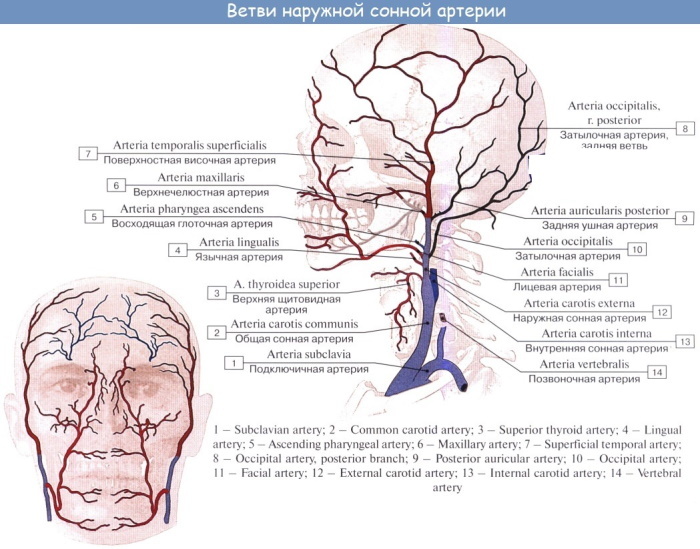
Diagram of the branches of the human carotid artery
The internal carotid vessel penetrates the temple in the cranial cavity, carrying blood to the eyes and brain. The subclavian artery is separated to the left of the aortic arch, and on the right continues the brachiocephalic trunk. This is followed by the internal thoracic and vertebral arteries. The axillary vessel continues the subclavian and passes into the brachial vessel.
Then arteries follow:
- beam;
- ulnar;
- palmar.
The arc is continued by the thoracic and abdominal aortas, which branch to:
- trachea;
- bronchi;
- parenchyma;
- the esophagus;
- pericardium;
- diaphragm;
- sternum;
- peritoneum;
- kidneys;
- genitals;
- Gastrointestinal tract;
- liver;
- pancreas;
- spleen.
Arteries branch off from the abdominal aorta:
- iliac;
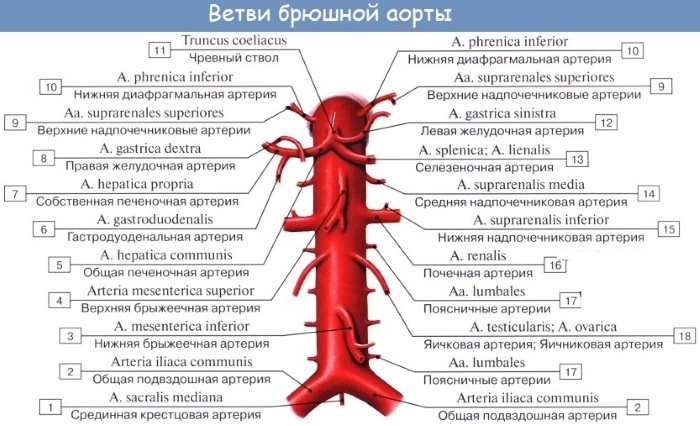
The branches of the abdominal aorta. - femoral;
- popliteal;
- tibial, nourishing feet and legs.
Functions
Human arteries (their layout is presented in the article) are inherently transmitting vessels. The largest of them branch off from the heart and lungs and follow along the spine to the main skeletal bones. Both oxygen-enriched and unsaturated blood can move through the arteries.
The vessels that carry blood from the heart are resistant to stretching. Therefore, their anatomical structure changes over time. Namely: in large arteries, the inner layer is thickened, and in more distant arteries, the outer and middle membranes.
The blood vessels leading the biological fluid to organs and tissues have the following functional characteristics:
- shipping;
- protective;
- exchange;
- regulatory.
Anatomy and structure
The arterial walls are layers:
- intimacy (internal);
- media (medium);
- adventitia (external).

In anatomy, arteries are distinguished:
- By type of walls. Vessels in this case can be:
- muscle (these include precapillaries and arterioles, which tend to contract in waves);
- transitional (tubes with medium diameter and contractility);
- elastic (aortas and large arteries that tolerate fluctuations in blood pressure well).
- By the place of blood flow and location in the body:
- extraorgan;
- parietal;
- intraorgan;
- visceral.
- By the type of branching (main and loose).
The arterial walls are dominated by collagen tissue and muscle cells due to the higher pressure than in the veins. After being stretched with a large amount of blood, the aorta instantly returns to its original state due to its elastic characteristics.
The pressure in the arteries causes the heart during left ventricular systole. In more distant vessels, contractile movements will create muscles located in the middle membranes of these transport structures.
Human arteries (their layout is noted below) are capillary blood vessels. Such highways conduct vital red fluid through themselves to all internal organs. All arteries taken together form an extensive and branched transport system.
The main arteries include:
- renal;
- shoulder;
- sleepy;
- femoral;
- iliac;
- subclavian;
- mesenteric vessels;
- aorta;
- celiac trunk.
Possible diseases
The main arterial diseases that lead to thrombosis and embolism are:
- Raynaud's pathology;
- Burger's syndrome;
- diabetic angiopathy;
- atherosclerosis of peripheral vessels;
- obliterating endarteritis.
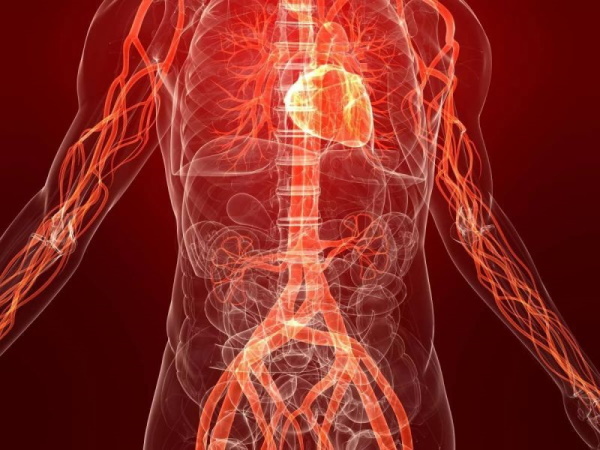
Symptoms such as:
- skin necrosis;
- fainting and migraines;
- the appearance of trophic ulcers;
- severe fatigue;
- discoloration of the skin (darkening or pallor);
- insomnia due to pain;
- cold feet and hands;
- hypotension or hypertension;
- numbness of the legs;
- lameness.
Raynaud's disease
With this pathology, narrowing of the arterioles and precapillaries occurs, and the blood supply is also impaired:
- nose;
- ears;
- stop;
- chin;
- hands.
Vascular spasms with Raynaud's phenomenon are accompanied by:
- ripple;
- change in skin tone;
- pain syndrome;
- tingling sensation;
- numbness.
Human arteries (the layout is described below) keep the body alive and nourish its tissues. The variety of these vessels always helps to maintain blood flow in an active state. When a problem arises, other, even non-working, capillaries are constantly included in the case. But among them there are irreplaceable ones that need urgent treatment.
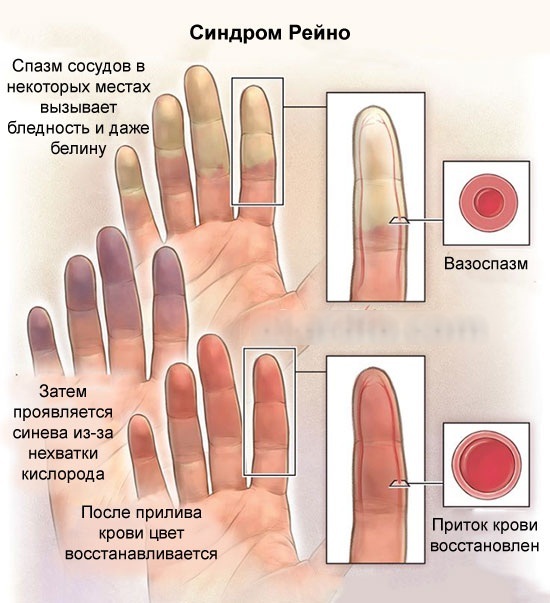
The table below describes the stages of Raynaud's disease and their symptoms:
| Stage name | Signs |
| Angiospastic | Short-term vasospasm from stress and cold; burning and pain in the fingers; reduced sensitivity; blanching of the integument |
| Angioparalytic | Longer bouts of vasoconstriction; hypersensitivity to cold; pronounced cyanosis; swelling; strong pain |
| Trophoparalytic | Tissue ischemia due to impaired blood circulation; the occurrence of ulcers; complete intolerance to low temperatures; reduced performance |
Burger's disease
The second name of this inflammatory process is thromboangiitis obliterans. It narrows the small and medium vessels of the feet and hands. With the identified pathology of Buerger, they turn to rheumatologists and vascular surgeons.
The disease can sometimes affect the following arteries:
- visceral;
- cerebral;
- coronary.
With peripheral pathology Bürger:
- ulcers form;
- manifest acrocyanosis and migratory thrombophlebitis;
- the major arteries affected lead to coronary artery disease of the legs.
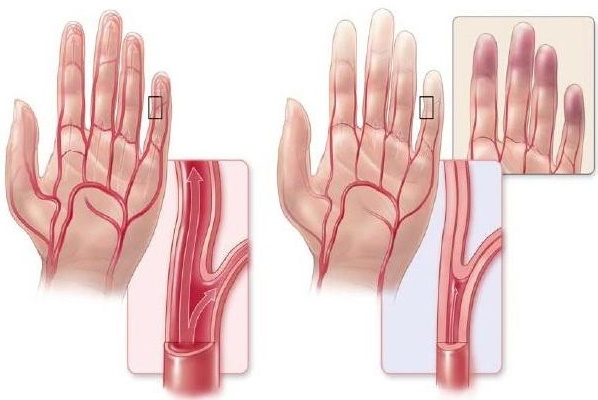
Mixed form of the disease:
- causes abdominal symptoms;
- changes the lungs;
- affects the brain and heart;
- destroys the kidneys.
The developing Buerger's syndrome can lead to:
- muscle and cutaneous atrophy;
- gangrene;
- hyper- and anhidrosis;
- trophic ulcers;
- hyperpigmentation;
- necrosis;
- swelling.
Diabetic angiopathy
People with diabetes mellitus are susceptible to this disease.
Angiopathy mainly affects:
- kidneys;
- legs;
- brain;
- a heart;
- eyes.
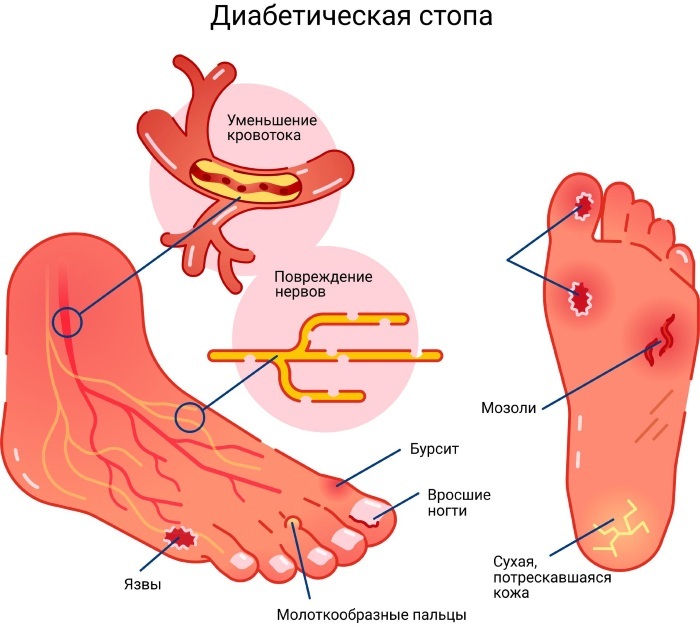
Diabetic foot
There are several types of pathology:
- heart;
- macro- and microangiopathy;
- peripheral vessels of the legs;
- retinopathy;
- encephalo and nephropathy.
Patients with diabetic angiopathy should be evaluated by specialists such as:
- cardiologist;
- vascular surgeon;
- neurologist;
- ophthalmologist.
Complicated forms of the disease include:
- impaired cerebral circulation;
- gangrene;
- heart attack;
- partially or completely lost vision;
- renal failure.
Atherosclerosis of the extremities
Lead to obliterating atherosclerosis:
- hyperlipidemia;
- diseases that disrupt material exchange;
- regular nervous stress;
- angiospasms;
- sedentary and sedentary lifestyle;
- hypertension;
- heredity;
- obesity;
- alcohol and smoking abuse;
- food with unhealthy fats.

Atherosclerosis of the vessels of the lower extremities
Peripheral atherosclerosis is manifested by:
- numbness of the limbs;
- lack of pulsation in the lower extremities;
- nocturnal cramps in the ankles and calves;
- skin ulcers that won't heal;
- rapid fatigue;
- detachment of nails;
- muscle weakness;
- pallor or cyanosis of the affected areas.
Obliterating endarteritis
With this disease, the peripheral arteries of the extremities are affected, which leads to them:
- stenosis;
- obliteration;
- ischemia.
Clinical symptoms of obliterating endarteritis are:
- trophic lesions;
- gangrene;
- lameness;
- necrosis;
- pain in the limbs.
Treatment methods
Along with medications, arteries are also treated with special procedures and diets.
Such an integrated approach to vascular therapy:
- prevents the occurrence of complications;
- improves the general condition of the body;
- eliminates pathology.
Medications
Vascular preparations are divided into:
- nitrates such as Nitrosorbitol and Nitroglycerin;
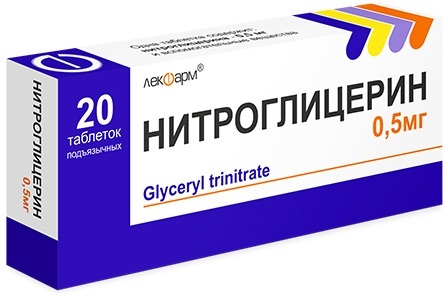
- neurotropic: Validol, Reserpine;
- myotropic: Dibazol, Euphyllin.
Human arteries (the layout is described in the text) are combined into a special system, which consists of a large and small circles of blood circulation. Large cylindrical vessels are adjacent to the first, and small ones to the second. The largest and most important artery is the aorta. All other vessels branch off from it.
Sick arteries can also be treated with the following groups of medicines:
1. Calcium blockers that come in 3 generations:
- The first includes funds with:
- diltiazem - Diazem (190 rubles);
- nifedipiniom - Cordipin (100 rubles);
- verapamil - Finoptin (50-85 rubles).
- The 2nd generation includes:
- Tiapamil;
- Clentiazem (85-270 rubles);
- Nimodipine (2700 rubles).
- The third generation is Norvask (200 rubles) and Amlodipine (36 rubles).
2. Heart remedies: Adonizide and Cardiovalen (130-190 rubles)
3. Preparations with nicotinic acid, for example, Enduracin (340 rubles).
4. Herbal remedies:
- Cavinton (105 rubles);
- Bilobil (330 rubles);
- Vinpocetine (30 rubles);
- Tanakan (580 rubles).
5. Medicines that strengthen the walls of blood vessels:
- Detralex (500 rubles);
- Askorutin (80 rubles);

- Antistax (470 rubles);
- Venoton (500 rubles).
6. Pain relievers Imigran and Maksalt.
7. Anticoagulants:
- Hirudin;
- Dicumarol;
- Heparin.
8. Antiplatelet agents:
- means with acetylsalicylic acid;
- preparations with Ginkgo Biloba extracts;
- vitamin E.
9. Vascular cleansing agents:
- Vinex (4000 rubles) and Antiox (1200-2000 rubles);
- Capilarin or Corbalance;
- Cardiomagnet (130 rubles);
- Cinnarizine (40 rubles).
10. Angiovitis (196 rubles).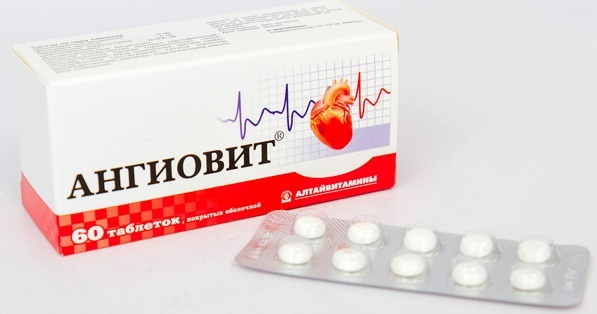
11. Nootropics and homeopathic medicines.
For patients with diabetic angiopathy, it is advisable to take (necessarily according to the doctor's prescription):
- diuretics;
- statins;
- vasoactive and biogenic substances;
- antioxidants;
- metabolists;
- vitamins;
- angioprotectors;
- neurotropic drugs.
With peripheral atherosclerosis, they usually take:
- anticoagulants;
- nicotinic acid;
- sequesters of bile;
- fibrates;
- statins.
In the treatment of obliterating endarteritis, the following are used:
- Pipolfen or Diphenhydramine;
- novocaine solution;
- Streptokinase or Fibrinolysin;
- anticoagulants;
- tocopherols;
- ganglion blocking drugs;
- ascorbic acid;
- myotropic substances;
- Methionine;
- antispasmodics;
- Lipocaine;
- Prednisolone.
Traditional methods
Medicinal herbs and plants are suitable for strengthening blood vessels and improving their patency. Folk recipes with similar means help get rid of bad cholesterol.
Thanks to this, it happens:
- normalization of pressure;
- disappearance of migraines;
- increased efficiency and mood.
The most successful recipes for supporting diseased vessels are as follows:
- Rosehip berries and herbs are collected in equal parts:
- meadowsweet;
- dryweed;
- motherwort.
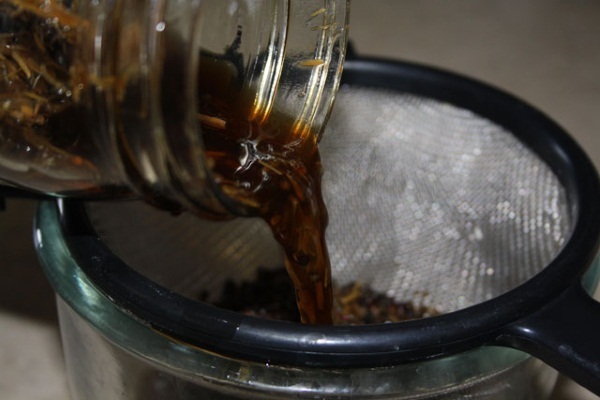
Further 4 tbsp. l. 1 liter of boiling water is poured into this mixture and insisted for 8 hours. The prepared drink is drunk within 2 months. 0.5 st. 3 p. per day.
- Take 1 tbsp. l. finely chopped barberry roots and bark and pour 0.5 liters of boiling water over them. Then they all insist for 4 hours. The resulting drink is consumed 100 ml four times a day, before meals.
- Dry bay leaves in the amount of 7 pcs. boil over low heat for 5 minutes in 0.3 liters of boiling water, then insist for 4 hours. The broth is then drunk a little for 3 days in a row.
Thyme also works well on the affected arteries. It relaxes their walls and also improves blood circulation. But thyme is not recommended to be consumed every day due to its strong vasodilating effect.
An infusion is prepared from this plant, which is taken 1 p. in 3 days. To obtain such a remedy, 1 tbsp. l. dry thyme is poured into 0.5 liters of boiling water and insisted for 1 hour in a sealed container. The drink is consumed in 1/3 tbsp. before meals (three times a day).
Arteries transport blood throughout the human body. The further these structures are located from the heart, the more they become refined. According to their scheme of location, it can be seen that inside the body they are almost everywhere. These important components of the circulatory system are structurally similar to each other.
For people suffering from atherosclerosis, instead of tea, it is useful to brew herbal preparations from:
- sweet clover;
- chestnut;
- rose hips;
- raspberries;
- nettles.
In the case of cleansing blood vessels, they have proven themselves well:
- honey;
- propolis;
- wine and juice therapy;
- massage;
- leech therapy;
- oils and compresses.
Patients with Raynaud's disease may benefit from taking:
- fir baths;
- onion juice mixed with the same amount of honey;
- the fruits of the Chinese lemongrass.
For people with diabetic angiopathy, the following will be helpful:
- lilac;
- chicory;
- blueberry;
- chamomile inflorescences;
- linden leaves;
- dandelion;
- clover petal baths;
- compresses;
- massage.
With atherosclerosis, it will be appropriate to use:
- motherwort;
- rose hips;
- dill seeds;
- hawthorn;
- garlic;
- St. John's wort;
- marsh caddie;
- strawberries;
- leaves of coltsfoot;
- horsetail.
It is useful for patients with obliterating endarteritis to drink decoctions and tinctures from:
- immortelle;
- St. John's wort;
- hawthorn;
- valerian;
- mint;
- cumin;
- thyme.
Other methods
Other treatments for arterial disease include:
- aortic aneurysmectomy;
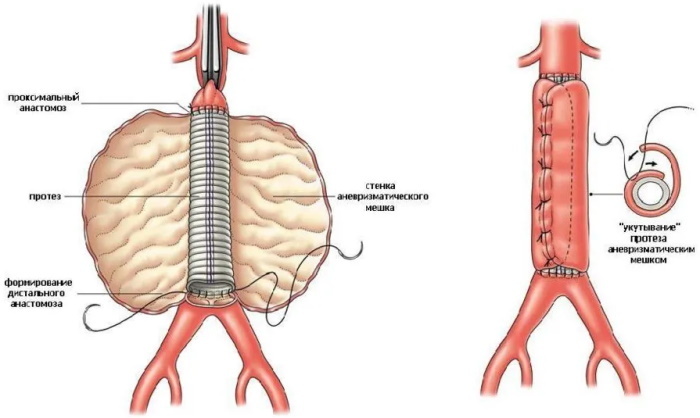
- extracorporeal detoxification of blood vessels during obliteration;
- electromyostimulation using impulse currents;
- magnetotherapy;
- electrophoresis;
- preventive or rehabilitative exercise therapy;
- laser and acupuncture;
- hyperbaric oxygenation;
- cryostripping;
- bypass grafting;
- phlebectomy;
- the use of an arterial fistula;
- profundoplasty;
- arterial stenting;
- sclerotherapy;
- arterial coagulation with radio frequencies.
For thromboangiitis obliterans apply:
- Vasaprostan;
- Iloprost;
- Prednisolone;
- plasmapheresis;
- hemosorption;
- the introduction of Perftoran or Oxyferol;
- sympathectomy of the chest or lower back.
Arteries of patients with atherosclerosis:
- prosthetics;
- shunt;
- undergo stenting and angioplasty.
For obliterating endarteritis, apply:
- radical surgery if there is sepsis of the extremities;
- magnetic therapy;
- electrophoresis;
- medicinal baths;
- UHF therapy;
- thermal procedures;
- ultrasound;
- diadynamic currents;
- pressure chamber;
- the introduction of oxygen under the skin;
- gymnastics;
- massage.
For the prevention of arterial problems, doctors recommend:
- to be regularly examined by narrowly focused specialists;
- minimize stressful impact;
- follow an anti-sclerotic diet and rationalize nutrition;
- regularly maintain physical activity;
- optimize sleep and wakefulness;
- give up alcohol and smoking;
- adhere to a suitable age and body weight;
- control the level of cholesterol and sugar in the body;
- wear only comfortable and suitable footwear for diseased vessels of the lower extremities.
The essence of the arteries is to level the flow of blood that is released into the aorta. According to their arrangement, it is noticeable how they gradually pass into the capillaries, from which the liquid connective tissue of red color enters the veins. The state of the vital vessels of a person must be constantly and carefully monitored, avoiding their narrowing and blockage.
Video about human arteries
Anatomy of the human circulatory system:



